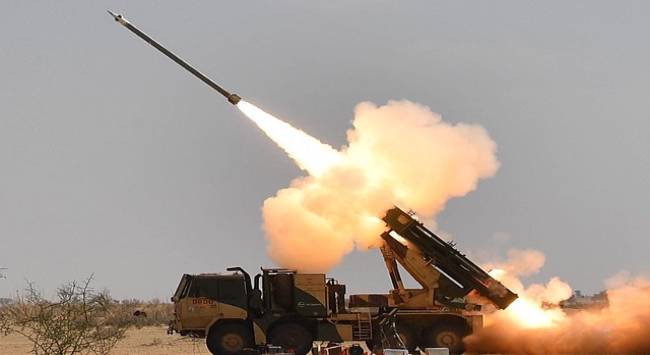Summary
India’s strategic community is beset with the prospects of a two-front war along the country’s northern and western borders. The growing military collusion between Pakistan and China has raised anxieties of active military cooperation during crises and wars. Can nuclear weapons help India achieve deterrence against the prospects of a two-front war with Pakistan and China?
India’s retired Chief of Army Staff, M M Naravane, recently touched on an anxious subject in India’s strategic thought: the prospects of a two-front war with China and Pakistan. Following the Galwan crisis between India and China in the summer of 2020, the spectre of a two-front war reached a fever pitch among India’s strategic community. India is perhaps the only country in the world involved in severe territorial disputes with two nuclear-armed neighbours – China and Pakistan – which also have a close strategic relationship, if not an outright alliance.
Many argue that facing a coordinated military manoeuvre from a relatively weak but prickly and resolute military power like Pakistan and a highly militarily capable China is beyond India’s capability to resist and defend. India should, therefore, diplomatically settle disputes with either of its two adversaries.
Naravane’s argument, however, is different. First, he believes that the military naysayers who argue it is impossible to fight China and Pakistan may be overemphasising their case. Such an assertion goes against the grain of military wisdom. Even great powers have deemed it challenging to fight simultaneously on two fronts, as with Germany in the First and the Second World Wars. Even the United States (US) had to prioritise the Atlantic front over the Pacific front during the Second World War. However, small states like Israel have proved that fighting along multiple fronts and emerging victorious is possible.
Second, unlike others who deem a diplomatic solution lies in India’s accommodation of either Beijing or Islamabad, Naravane hints that accommodation is not the only solution available. Diplomatic strategies must consider using strategic partnerships to create deterrence and, if needed, military assistance in warding off India’s two major adversaries. Rather than appeasement, New Delhi should focus on possible alliance building.
India has had a history of leveraging great powers to mitigate the two-front threat – a classic strategy in India’s playbook. India used the détente between the US and the Soviet Union during the 1965 crisis to keep China from intervening in Pakistan’s favour. Even under Sino-US collusion during Richard Nixon’s presidency, beginning in early 1969, India leveraged the Sino-Soviet differences to its advantage. The main reason for the treaty of friendship signed with the Soviet Union in August 1971 was to neutralise the Chinese threat.
If the prospects of a two-front war become apparent, India can use its old playbook again. Depending upon the seriousness of the situation, a defence treaty between India and the US is not beyond imagination. Even without an explicit security arrangement, decision-makers in Beijing will have to calculate the risk of American involvement in case China actively interferes in Pakistan’s favour during an Indo-Pak conflict. Pakistan’s involvement in a Sino-Indian confrontation is even more doubtful, given its precarious economic condition and dependence on Western and Bretton Woods institutions. American economic statecraft alone is sufficient for Pakistan’s non-intervention. Since the Kargil war, the US has increasingly leaned on Pakistan to India’s advantage. The Indo-US relationship, therefore, is a critical element of India’s strategy to counter the two-front threat. It assists India’s internal balancing through more significant economic, military and technological build-up and creates enough uncertainties and risks for India’s adversaries to follow up on the two-front threat.
However, the example of Israel’s success in fighting multiple front wars is over-stretching the case. The military context of Israel’s 1967 victory is entirely different from the capabilities, terrain and political reality in South Asia. Furthermore, in 1973, Israel did come close to losing a multi-pronged attack from its Arab adversaries. Neutralising Pakistan through pre-emption is more easily said than done, given its relatively robust military capabilities. Moreover, such pre-emption would certainly attrite significant Indian military capabilities. It is difficult to imagine the effectiveness of a degraded military’s warfighting capabilities vis-à-vis China.
Perhaps the solution to India’s two-front war threat scenario lies in its nuclear deterrence. Even if the perceptual deterrent of US involvement fails to restrain China and Pakistan from coordinating a military offensive against India openly, New Delhi, by necessity, will consider it a significant escalation, forcing it to cross its nuclear threshold. India’s atomic posture vis-à-vis Pakistan is already moving towards first use. Decision-makers in Beijing and Islamabad will be failing their strategic faculties to think that a two-front war will not involve nuclear use by India. Nuclear weapons have rendered major territorial revisions in South Asia highly improbable, as is evident in numerous crisis scenarios since the region’s nuclearisation in the late 1980s. Chinese and Pakistani leadership will have to contend with the possibility of nuclear escalation in case of a two-pronged attack against India. If New Delhi believes a two-front war scenario to be highly probable, it can simply revise its nuclear doctrine and categorically state that military coordination between Pakistan and China will entail a nuclear response. India, therefore, needs to build adequate nuclear deterrence capabilities to send a clear message against any military cooperation for opening a two-front war against itself by China and Pakistan.
. . . . .
Dr Yogesh Joshi is a Research Fellow at the Institute of South Asian Studies (ISAS), an autonomous research institute in the National University of Singapore (NUS). He can be contacted at yogeshjoshi@nus.edu.sg. The author bears full responsibility for the facts cited and opinions expressed in this paper.
-
 More From :
More From :
-
 Tags :
Tags :
-
 Download PDF
Download PDF



